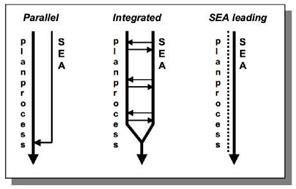In Germany environmental planning and landscape planning can be distinguished (von Haaren, 2004; Kloppel et al., 2004; Jessel & Tobias, 2002; Riedel & Lange, 2001). They are the fundamentals for sustainable planning and the basics for decision-makers to take landscape functions into consideration (BfN, 2002).
1.1.1 Environmental planning
There are a lot of policies influencing the landscape. These are e. g. the European Landscape Convention, the Environmental Impact Assessment Act, the Strategic Environmental Impact Assessment Act or the Habitat Directive (Koppel et al., 2004; Umweltbundesamt, 2008). This leads to the recognition of the value of landscapes in law and the requirement of public participation processes (Steinitz, 2010; von Haaren, 2004; a. o.).
In contrast to Environmental impact assessment (EIA) on the project level, Strategic Environmental Impact Assessment (SEA) covers a wider range of activities, a wider area or sometimes a longer time span and identifies and evaluates the environmental consequences of proposed policies, plans or programs to ensure that the consequences are addressed at the earliest possible stage of the decision-making process (European Commission Environment DG, 2001; Gontier, 2007; Koppel et. al., 2004; Gontier et al., 2010). For this reason the focus of implementing sustainability aspects into the decision-making process is more effective and more sustainable-driven than being reactive on the EIA-level.
There exist three combinations of SEA and planning process (see Fig. 2).
The objectives of the intervention and environmental impact assessment provisions are to ensure that individual projects, plans or programs are performed with as little impact on the environment and nature as possible. This does not entail a separate procedure in its own right but rather takes place as part of the regular planning, permit and approval procedures e. g. of a road planning project or the urban development planning process (Heins & Pietsch, 2010; Koppel et al., 2004). The intervention provisions require registration and assessment of the effects that the planned project or plan can be expected to have on the functional capacity of the ecosystem and appearance of landscapes. In addition, the EIA and SEA is also concerned with the effects that such measures can have on human health and on cultural heritage (Federal Ministry for the Environment, Nature Conservation and Nuclear Safety 1998; Riedel & Lange, 2001; Busse et al., 2005; Koppel et al., 2004; Georgi & Peters, 2003; Georgi, 2003; Umweltbundesamt, 2008; Hohn, 2008; Jessel et al., 2009; Hendler, 2009; Wiegleb, 2009). Therefore the fundamental components of an EIA and SEA although there are variations around the world are:
– Screening
– Scoping
– Assessment and evaluation of impacts and development of alternatives
– Reporting
– Review
– Decision-making
– Monitoring, compliance, enforcement and environmental auditing (Commission for Environmental Assessment, 2006; von Haaren, 2004; Riedel & Lange, 2001; Koppel et al., 2004).
|
Fig. 2. Combinations of SEA and planning process (Commission for Environmental assessment, 2006) |
In Germany mitigation and landscape envelope planning have a special role in the whole spectrum of environmental planning and nature conservancy. It is an instrument that is always tied in with the formal legal planning process such as e. g. road planning, zoning of areas for wind energy or solar panels (Riedel & Lange, 2001; Schultze & Buhmann, 2008; Koppel et al. 2004). Landscape envelope and mitigation planning is that instrument that optimizes the ecological balance of the overall project and to describe the compensation measures (BMV 1998). In the logical sequence of work steps Landscape envelope and mitigation planning uses the results of an EIA and is the legally binding part of the planning (Koppel et al., 2004; Schultze & Buhmann, 2008).
Based on the Habitats Directive and the Birds Directive sites had been selected according to EU standards to create the NATURA 2000 network. If any plan or project either itself or in combination with other plans or projects might have significance impact on a given site an impact assessment is required (Koppel et al., 2004; European Commission Environment DG, 2002).
The key issue to identify the significance impact is an assessment that covers:
– habitats listed in Annex I of the Habitats Directive, including their characteristic species.
– species listed in Annex I of the Habitats Directive and bird species listed in Annex I and Article 4 (2) of the Birds Directive, including their habitats and locations.
– biotic and abiotic locational factors, spatial and functional relationships, structures, and site-specific functions and features of importance to the above mentioned habitats and species (Bundesamt fur Naturschutz, 2012).
The impact assessment should lead to alternative solutions, compensatory measures and to preserve the overall coherence of the NATURA 2000 network (European Commission, 2007). For specific information about the procedure, the exceptional circumstances when a plan or project might still be allowed to go ahead in spite of a negative assessment see European Commission Environment DG (2002).




